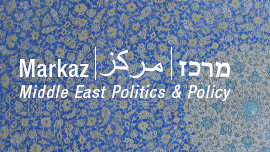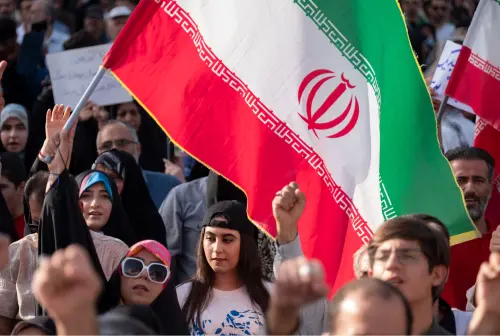Editors’ Note: Israelis will go to the polls on March 17 to elect the 20th Knesset, Israel’s parliament, which will then form a new government to replace Prime Minister Benjamin Netanyahu’s current one (he hopes to head the next government as well.) We will follow the run-up to the elections here on Markaz, the blog of the Brookings Center for Middle East Policy.
It is, once again, the time for political jockeying in Israel. With 10 weeks to go before the general elections, parties across the political spectrum are now in full swing negotiations to form their candidate lists.[*] Ideology is part of the story (in fact, and despite widespread cynicism, Israeli politics are relatively issue-based), but personal rivalries and machinations make for an excellent—though high-stakes—soap opera.
Three Observations on the process thus far:
1. Netanyahu and the Likud: For Prime Minister Benjamin Netanyahu, the past week was one of relief—no major crisis hit as his Likud party chose its list in primaries held December 31st. The Likud in recent years has garnered a reputation for being far to the right of its average voter. Far-right politicians such as Moshe Feiglin—who rose to fame, or infamy, in heady days of the anti-Rabin vitriol before the prime minister’s assassination—enlisted scores of new recruits to the party to vote in the primaries, even though most of them will likely vote for a party to the right of the Likud in the general election.
Last week’s Likud primaries saw Feiglin himself booted down the list—likely outside the realistic range of seats for the Likud. With minor hiccups, Netanyahu (who was also overwhelmingly confirmed as leader of the party after his only real rival, former Minister Gideon Sa’ar chose not to re-enter politics and run) came out unscathed.
But herein lies Netanyahu’s problem. The Likud today is happy to get through an uninspiring primary with no new, exciting candidates, merely a list that is no worse than the previous one. Though Netanyahu remains the frontrunner to form the next coalition there is a palpable sense of vulnerability to his campaign and widespread Netanyahu fatigue among the rest of the political elite.
The Likud today does not have the feel of a winning party. The party is still likely to form the next coalition (something many like to forget), but far from the prohibitive favorite just a few months ago, Netanyahu and his party now seem like yesterday’s news.
2. Naftali Bennett and the Jewish Home: Today, the excitement on the Right is concentrated in one party, the Jewish Home led by Naftali Bennett. Before the previous elections in 2013, Bennett took over the paragon of tired, old parties—the National Religious Party (NRP)—a modern-orthodox, nationalist party with strong support among Israeli settlers in the West Bank.
Though settlers are now entrenched in all walks of Israeli life, settlers and the national religious community often feel marginalized by mainstream Israeli society. Both by choice and by perceived necessity, there has been a sense among the national-religious of being a minority—a “sector,” or even “The Sector” (HaMigzar) in Israeli parlance.
With Bennett, The Sector leapt back into the mainstream of Israeli society and politics. A party that cherishes settlement in the West Bank elected a resident of Ra’anana, an upper-class, largely secular town north of Tel Aviv in the heart of Israel proper. Though its constituency is trending toward more strict orthodoxy, the party chose a leader who rejects the authority of Rabbis over politics, wears a small kippa (skullcap or yarlmuke) and speaks to secular Israelis as one of their own. Rather than a religious or messianic zealot, in the mold of the predominant settler stereotype, Bennett is a (very) nationalist hawk (for a sense of his views and style, see his discussion with Martin Indyk at our Saban Forum last month, described in this blog here).
Bennett also embodies the successful new Israeli—he served as an officer in elite combat units and went on to make many millions of dollars in an IT start-up company.
The move of the former NRP to the mainstream has now paid off. Polls suggest that Bennett’s party will gain in the next elections, and Bennett hopes to be appointed Minister of Defense. In recent weeks a wave of candidates have joined the party, including Dani Dayan, former (secular) chairman of the settler Yesha Council, Yinon Magal, a well-known journalist (the latest in a long list of journalists to enter politics and again, not a religious man) and Ronen Shoval, the infamous former head of Im Tirzu, an organization which focused on exposing “unpatriotic” and foreign influences in leftist Israeli civil society.
The Jewish Home hopes to emerge the big winner of the election, not leading the government (yet), but in striking distance of national leadership in the post-Netanyahu era.
3. Herzog, Livni and Labor: It’s not just the far right that is galvanized. There is new life in the Labor party, following the announcement of a joint list for Labor, headed by Isaac (“Bouzi”) Herzog, outgoing Head of the Opposition, and Hatnua, the party of Tzipi Livni, who until recently served as Justice Minister under Netanyahu, and was in charge of negotiations with the Palestinians. (Reportedly, the Herzog-Livni negotiations were partly conducted during the Saban Forum. You can hear Herzog address the Forum in conversation with Jeffrey Goldberg here, and earlier this year at Brookings, in conversation with Tamara Wittes, here.)
Surprisingly, Herzog accepted Livni’s demand that if they form the next government, Herzog would be prime minister for the first two years followed by Livni for the next two. This is a major coup for Livni who was doing very poorly in the polls and needed an alignment with another party to survive the next election, in which the electoral threshold will be higher than before (at 3.5 percent). Herzog, for his part, gained important momentum in the polls, and the joint list he heads is now roughly tied with Likud as the largest party, with perhaps 20 of the votes.
The move is important for Herzog in two ways: It establishes him as the main challenger to Netanyahu in a highly fractured political field; and it positions Labor in the center-left, in an attempt to shed the now very unpopular “leftist” label, much like Ehud Barak did in 1999 when forming the “One Israel” alignment, with Herzog as one of his aides.
The new alignment is tentatively called “The Zionist Camp,” again a nod to the Center. The name is also part of an attempt to frame the Right as leading away from the Zionist ideal of a Jewish-majority democratic state, both in recent legislation that puts dents in the democratic and equality-based legal foundation of the state, and in the danger to the Jewish majority of the state embodied by the right-wing approach of holding on to, or even annexing parts of, the West Bank.
But the Herzog-Livni alliance does not fundamentally change the math of the Israeli elections. The leader of the largest faction has a perceptual advantage, but under Israeli law, the president tasks one MK with forming a government, based on his or her chances to form a new coalition, whether or not they lead the largest faction. To form a coalition, in other words, Herzog needs a majority of the incoming Knesset to support him, or at least oppose and block Netanyahu.
And while the Herzog-Livni alliance has strengthened Labor in the polls, it has mostly drawn votes from Livni’s old party and from other parties within the center-left bloc. The right-wing religious bloc, traditionally Netanyahu’s base, still holds a commanding lead in the polls.
To beat Netanyahu, in other words, other candidates must fracture his governing coalition; a path that runs through Netanyahu’s old ally, Avigdor Lieberman, whose Yisrael Beitenu party is engrossed in a widespread corruption investigation, his former Likud minister Moshe Kahlon, struggling to form a new centrist party (Kulanu), or his former allies among the Ultra Orthodox parties, now in the thralls of bitter infighting, with the breakup of Shas. More on these parties in future posts in this space.
[*] Under Israeli electoral law—(a “single district, proportional representation” system)—voters do not elect candidates or regional representatives, but rather choose one national list, a set list of candidates offered ahead of the polls by a party or an amalgam of parties. Each list that passes a minimum threshold (recently raised to 3.25 percent of the vote) is then awarded seats in the 120-seat Knesset, in proportion to the number of votes it received, nationally. The result is a highly representative—but highly fractured—party system. After the elections, the president (who is not up for general election), consults the elected factions and tasks one Member of Knesset with forming a government that can garner support of a majority of the Knesset (this need not be the leader of the largest faction, merely the MK with the best chance of forming a governing majority). In a party system as fractured as the Israeli one, this invariably entails forming coalitions among various factions in the new Knesset.
The Brookings Institution is committed to quality, independence, and impact.
We are supported by a diverse array of funders. In line with our values and policies, each Brookings publication represents the sole views of its author(s).




Commentary
Israeli Elections: Tell Me Who Your Friends Are
January 5, 2015